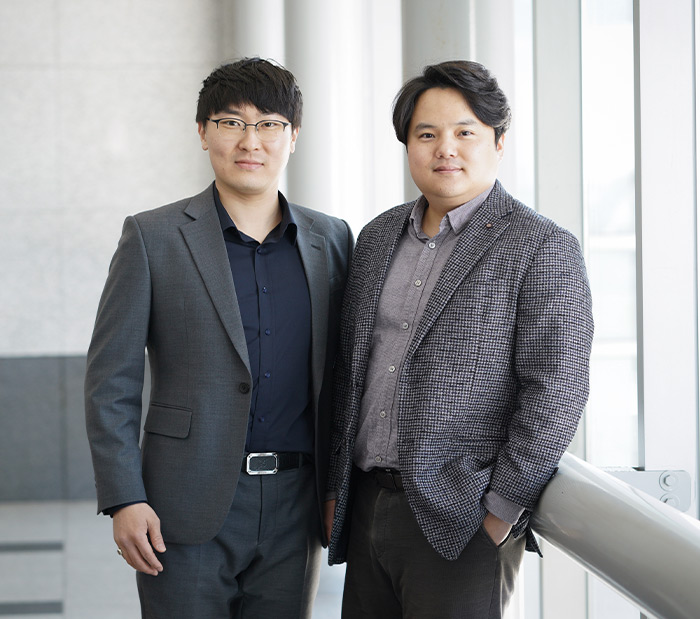Research Stories
Development of a highly transparent and multifunctional wearable nanogenerator
Multifunctional piezoelectric nanogenerator for energy harvesting and motion sensing in next-generation wearable electronics - Winner of 2022 SKKU Graduate Student Paper Award
SKKU Advanced Institute of Nano Technology
Prof.
AN, SEONGPIL
SAINT faculty Seongpil An and Il Jeon co-research team
Piezoelectric nanogenerators (PENGs) that harvest electrical energy from ubiquitous mechanical motions have recently attracted significant attention as a environmentally friendly next-generation energy harvesting technology that does not rely on fossil fuels. Unlike previous research, the PENG developed this time includes excellent transparency and mechanical durability, expected to be widely applicable in various industries. In particular, since the PENG that produces electrical energy through body motions can be used as a self-powered high-sensitivity motion detecting sensor, which is expected to be used in the field of next-generation healthcare wearable electronic devices.
Profs. Seongpil An and Il Jeon’s co-research team from SKKU Advanced Institute of Nanotechnology (SAINT) announced that they have developed a multifunctional transparent composite that can harvest energy, composed of piezoelectric polymer nanofibers and high-purity carbon nanotubes (CNTs) as the core materials.
In previous studies, silver nanowires or electrically conductive polymers, such as PEDOT:PSS, were used as electrodes for transparent PENGs. However, metal-based transparent PENGs have inherent issues of opacity due to their natural light reflection and scattering, while electrically conductive polymer-based PENGs have shown material limitations in mechanical properties with insufficient electrical conductivity.
The co-research team developed a multifunctional transparent composite capable of harvesting energy using a silicon-based elastomer embedded with piezoelectric polymer nanofibers and high-purity CNTs. The team developed piezoelectric P(VDF-TrFE) nanofibers with a diameter of 500 nm, 200 times thinner than a human hair, using the electrospinning technique and embedded them in a transparent sisilicon-basedlastomer PDMS. They also used a differentiated aerosol-assisted chemical vapor deposition (CVD) method to produce transparent CNT films for their use as electrodes in the development of a transparent PENG.
The electrospinning and aerosol CVD methods used in this study are not only simple to use but also easily scalable to larger production scales compared to other methods. Based on these excellent process advantages, it is expected to have a positive impact on the commercialization of related technologies in the future. In particular, in this study, the conductivity of the CNT electrode could be improved by 3.1 times through a simple chemical doping method.
The developed high-transparency PENG demonstrated decent energy harvesting performance that generated a voltage of 10 V or more even with relatively weak external force (F = 10 N). Additionally, it showed high energy harvesting performance under repetitive external force conditions of over 50,000 cycles, proving excellent mechanical durability and stability. Furthermore, when the external force was applied through a body part, such as fingers, it exhibited higher energy harvesting performance of up to 26.8 V through an additional effect of triboelectricity.
It is expected that the newly developed transparent PENG can be applied extensively in the rapidly growing fields of metaverse, virtual/augmented reality, as it can not only detect subtle movements of the human body in real time by attaching it to various parts of the body, but also generate voltage signals sensitively in response to changing external forces.
Prof. An said, “At SAINT, young professors who are actively engaged in research activities have formed a close relationship of solidarity, and joint research is being carried out in various directions. This research achievement is one of the results of such collaborative efforts, and it is expected to lead to more innovative research outcomes in the future.”
In addition, Prof. Jeon said that “This joint research was an impressive opportunity for two research groups with different strengths to integrate their expertise into a new research field. Prof An's research team could understand [CNT-based transparent conductive electrodes] while my team could work on [PENG devices], which opened up a new avenue for expanding our research areas.”
The lead author of the study, doctoral student Kiyong Kim said, “There is infinite potential for improving the energy harvesting performance of PENGs, and research should be conducted from various perspectives in the future.” The co-first author doctoral student Sangsu Lee added, “This study is the first report on the use of CNTs as electrodes in a nanogenerator, and we hope it will provide a new direction for research on transparent nanogenerators.”
This study was supported by the Basic Science Research Program (2021R1F1A1061404) and the New Faculty Research Fund (2021R1C1C1009200) through the National Research Foundation of Korea (NRF).
This study was published on January 18th in Advanced Functional Materials (IF: 19.924), a world-renowned academic journal in the top 5% of the material science field, based on the results that won the SKKU Graduate Student Paper Award. The lead authors of this paper are beginner in doctoral course, so their future research activities are highly anticipated.
※ Title: Highly Transparent and Mechanically Robust Energy-harvestable Piezocomposite with Embedded 1D P(VDF-TrFE) Nanofibers and Single-walled Carbon Nanotubes
(Journal Advanced Functional Materials, https://onlinelibrary.wiley.com/doi/10.1002/adfm.202213374)
▲Transparent PENG developed and its fabrication process
▲ Results of energy harvesting and sensing performances


